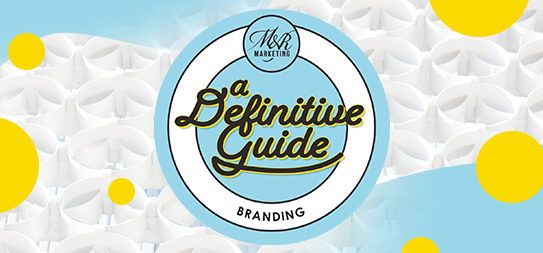
Regardless of your marketing strategy, no matter how many different platforms or tactics you employ, at the end of the day, every one of them will develop from and impact the future of your brand. Whether you’re running a single-person Etsy shop or a huge multinational business with employees on every continent, your brand is ultimately what will be responsible for attracting leads, setting customer expectations, establishing your role in your market segment, and determining what sort of face your company puts forward for the world to see.
Your brand – the collective name for the designs and content that comprise your company’s public identity – will drive:
- The nature of the audience you attract
- All of your marketing decisions
- Your purchasing and sales decisions
- Your digital presences
- Your pricing and sales structure
- The way your employees interact with your customers
So when we say that this guide to branding your company is an essential read, both for startups and established businesses, we’re not blowing our own horns. Your brand is important. Period.
What is a Brand (And Why Is It Important?)
What Is a Brand?
This is a big question with a few different answers, depending on how you view the world. A technical definition of the term “brand” might be something like:
A brand consists of unique visual and stylistic elements that, when taken together, define a particular business or other organization.
Looking at it that way, a brand is a collection of decisions that you make when you decide how you want your company to be represented to the general public:
- Logo
- Brand colors and fonts
- Mission, vision, and values
- Brand “voice”
- Customer service model
Or, to put it another way, a brand is technically a way for people to recognize that a product, service, piece of collateral, or even a particular verbal exchange (such as Chick-fil-A’s now-signature “my pleasure!” or Moe’s boisterous “Welcome to Moe’s!”) is associated with your company.
To go a little deeper, though, a brand is a story. It’s the story of your company and how it serves customers. It’s the story of your products and services and how they can solve people’s problems. Most of all, though, it’s the story of how your company is unique.
In the tech world, when dealing with a database, every record in a particular data set has an attribute known as a “primary key.” The primary key is a number, name, or other piece of information that is unique to each individual entry. For example, in a database of US taxpayers, each taxpayer’s social security number could be used as their record’s primary key.
In a way, your brand is your business’s primary key – the thing that identifies your locations, messages, advertising, and products as yours. It makes you different and memorable and creates the initial spark of engagement that eventually grows into a fully developed customer relationship.

Why Is Branding Important?
For just a second, imagine that your brand is a real-life person. This person is magically able to stand at the front door of every one of your stores, answer every phone call or email, deliver every product or service to the customer’s door, listen to your customers’ feedback, and otherwise engage at some level with every single interaction your company has with the general public.
Whether you realize it or not, that’s exactly what your brand is: a magical extra employee representing your company in every single interaction, active or passive, that your products, services, collateral, and employees have with your audience.
What does that person look like? What do they sound like? Are they fun and exciting? Are they dull and disinterested? Do they greet each customer as an old friend or as an unwelcome burden? Are they helpful and eager or withdrawn and standoffish?
In short, if your brand was a person, would you want to hang out with them?
Now, imagine that this magical employee consistently disappointed your customers by setting faulty expectations, misrepresenting your products, ignoring your corporate values, and being confusingly inconsistent; how well do you think customers would respond?
It’s not a stretch to imagine that many of those interactions wouldn’t just end without a sale. They’d end with a customer developing a distaste for your company and vowing never to even consider you as someone who could meet their needs.
That’s the importance of a brand. When done well, every single aspect of a company’s brand communicates positively with customers, establishing the nature of the relationship, building trust in your product or service’s consistency, and growing your reputation as a reliable provider of a quality product.
When done poorly, branding efforts are like having a bad interaction with everyone who enters your door.
How Do I Build a Brand?
This guide will divide the brand development process into three main sections.
In the first section, you’ll start the process by defining your corporate identity. Here, you’ll ask yourself several questions, and the answers will guide the rest of the process. In this step, you’ll be thinking broadly, making big-picture observations about your company, its goals and vision, its products and processes, and the descriptors you use to define your company’s identity. In short, you’ll be laying out the basic “beats” of the story you want to tell your audiences, both internal and external.
In the second, you’ll focus on developing the content-centered aspects of your brand. What is your mission statement? Your vision statement? What do you want your brand’s voice to be? In this step, you’ll define the type of language you use to tell the story you sketched out in the first step.
In the third section, you’ll think about logos, colors, and other design elements to build your visual identity. What kind of logo do you want? What colors and fonts best communicate your brand’s story to your audiences? In this section, you’ll be doing the fun stuff – figuring out what symbols best illustrate your story.
Ready to get started? Awesome.
Need Help Getting Your Branding in Order? We’re Ready to Step Up! Call M&R Marketing Today and Discover the Power of a Cohesive Branding Strategy: 478-621-4491
Step One: Who Are You? Defining Your Company’s Identity
Before you can start building your brand, the story that will inform so many of your decisions as you continue to grow your business, the first question you need to ask is: what is your business’s story? What makes your products, services, operations, interactions, etc. unique?
If you need some help getting started with this process, here are some questions to help you out:
- What was the idea or the discovered need that started your company?
- If you could solve one problem through your products or services, what would it be?
- What does your company do better than anyone else?
- How do your services impact and benefit your clients?
- What is it that wakes you up in the morning excited to do what you do?
- What’s the one thing you’d like to hear someone say about your company after an interaction?
Those answers, taken together, will go a long way toward showing you what your brand needs to communicate. Take as an example WidgetCo, a fictional manufacturer of attractive, ergonomic office furniture. Their answers might look like this:
- What was the idea or the discovered need that started your company?
- We discovered that too few offices are taking steps to reduce work-related injuries among their employees because of the poor aesthetics of most ergonomic furnishings.
- If you could solve one problem through your products or services, what would it be?
- To provide more office employees with fun, stylish, and attractive furnishing options that reduce the risk of repetitive motion injuries and other physical impacts of sitting at a desk all day.
- What does your company do better than anyone else?
- We provide comfortable and ergonomic designs that are stylish and fun but still appropriate for a professional environment.
- How do your services impact and benefit your clients?
- Our services allow companies to promote employee wellness, increase productivity, and decrease medical liability while maintaining an attractive and engaging office setting.
- What is it that wakes you up in the morning excited to do what you do?
- Being able to help people live healthier, more productive lives while designing beautiful pieces that embrace and even advance the state of furniture design art.
- What’s the one thing you’d like to hear someone say about your company after an interaction?
- We had fun working with this company.
What a wealth of information these few short answers contain! We can already start to frame out some ideas about this brand based solely on the sentences above:
- This brand is both professional and fun.
- This brand cares about people’s health.
- This brand is interested in being stylish and keeping abreast of trends.
We can also glean some things based on what’s not included in the answers:
- With no mention of price or affordability, this brand is interested in quality over price.
- With no mention of classic office furniture, this brand is not traditional or static.
- With no mention of home furnishings, this brand is a B2B rather than a B2C operation.
A story is beginning to take shape, along with (for the visual thinkers) some general ideas for what logos and other graphic design elements of the brand might look like.
As you go through this process, it might help to begin a running list with two columns: “We are” and “We aren’t.” As you consider the various ways your company should be presented to your audience, begin filling out the list with adjectives and descriptors that apply or don’t apply to your vision for your company. In our above example, the start of that list might look like:
We are…
|
We aren’t…
|
Remember, too, that brands can be aspirational. Your company’s vision statement, which we’ll be working on more in the next stage of brand development, is also part of your brand and should address the direction you want to take for your company in the future. If you want your company to become nationally recognized or want to eventually offer products made on every continent (except, probably, Antarctica), you can absolutely include those terms in your “We are/We aren’t” list.
Continue working on this list, and begin thinking about other aspects of your company that need to be conveyed in your brand:
- Our products/services are…
- Our customer service is…
- Our stores are…
- Our online shop is…
Once you’ve gotten a good grip on the terms that will best describe your company, you’re ready to start getting into specifics, beginning with the content components of your brand: values, mission, vision, and voice.
Step Two: What Do You Say? Creating Your Brand Content & Messaging
When most people think of a “brand,” they think of a logo. After all, that’s where the entire concept of “branding” came from – the practice (which we were surprised to discover started with the ancient Egyptians, not with cowboys in the Wild West) of marking livestock with a unique burn mark to indicate ownership.
A brand, however, goes well beyond the visual symbols that represent your company. Your brand comprises everything that defines and differentiates your company from others that offer similar products and services. That differentiation starts with a handful of statements: your core values, mission statement, and vision statement.
These three content components of your brand will help cement how you and your employees will make the decisions that create your brand’s public image. A fourth content component, your brand voice, will define how you present your values, mission, vision, and value propositions to your audience.
While you can develop the first three parts of your brand’s content components in any order or even at any time in your business’s journey (it’s never too late to adopt or revise your mission, vision, or values), it may be helpful to start with the one that will help you make decisions about the others as you proceed through your branding process: your core values.
Feel It in Your Core… Values
Each reader of this article falls within one of the following categories:
- We don’t have core values, and I don’t know what they are
- We have core values, but they have nothing to do with our business growth
- We have core values, our team knows them, and they are guiding our business forward
For those in group three – well done! You’re in a select group of businesses that understand who you are, and you’re allowing that knowledge to propel you toward growth in your market segment. For those in groups one and two, don’t be alarmed! You are in the majority among businesses, but by the end of this article, you’ll be prepared to create (and follow) your business’ core values.

What Are Core Values and Why Do I Need Them?
The core values of a business define what’s most important to your company, serve as your primary navigational tool, and help you decide where to invest your limited time and resources. Your core values answer one simple yet monumental question: what characteristics of our company, if they went missing, would leave us directionless and without meaning?
When you have established what’s most important to your company, you’ll find that core values save you from falling prey to the shiny object that takes your attention away from what you do best, like those times a customer asks about a service you don’t offer, or you lose a customer because of something you didn’t anticipate.
When things like that happen, it’s all too easy to let minor issues become the linchpins for sudden and usually unnecessary changes to your entire business model. With fully developed and well-understood core values defined for your company, you can lose this instinct to carry out these sorts of snapshot changes and instead give you one question to ask:
- How do we address this issue in a way that’s aligned with our core values?
As you answer this question consistently for every issue that arises or decision you must make, you’ll gain confidence in allowing your core values to make decisions for you.
How you engage your community, treat your team, serve your clients, and spend your money all communicate your core values. Your values aren’t your dreams or even your aspirations – they are who you consistently are. And when you’ve hired based on these values, they are also who your team consistently is.
At M&R, we established four core values that guide all our decisions – they are used for hiring, are shared with every new team member at orientation, are used as part of our team reviews, determine how we treat people, how we invest our time and resources, and how we interact with our clients. They are ingrained in our culture, which is made easier by our team knowing them and seeing them in action.
Here’s A Look At M&R Marketing’s Core Values:
- Relational: we are committed to cultivating deep, authentic relationships with our team and clients. The better we know each other and the more trust we have in our work together, the better the outcome will be.
- Insightful: we are committed to understanding the needs of our team, clients, and clients’ businesses by being attentive, caring, and others-focused.
- Innovative: we are committed to learning and exploring; this allows us to be on the cutting edge of technology, marketing trends, and intelligent decision-making.
- Passionate: we are committed to being engaged, excitable, and enthusiastic for life and work. We love what we do, and we desire to improve the lives of our team and our clients through our work and attitudes.
Get Started
As you plan to create your core values, carefully evaluate who should be at the table. Making these decisions 100% at the owner level could lead to poor results by omitting important voices from the conversation. Keep your team small but well-rounded, including members from various sections and at multiple levels within the company structure.
Once you’ve created a team, set up a planning session off-campus and rid yourself of all distractions. You’ll want to select one person to serve as a moderator and walk the team through a brainstorming session focused on the DNA of your company.
After you’ve compiled your list of core values, edit them down several times so they contain tight, succinct statements. At this point, you’ll want to establish a strategy to share your core values internally and externally.
Finally, be ready to act on them when tested. The next time you face a difficult decision, how will your core values guide that decision? Working in accordance with your core values may be difficult in the short term, but over time, if your core values are authentic, it’ll drive business growth.
For our example of WidgetCo International, their list of core values might include things like:
- Fun: Our team understands that shopping for office furniture through traditional channels can be drudgery, and we seek to inject fun into every step of the buying process.
- Stylish: Ergonomic furniture is no good for anyone if it makes the workplace look like a physical therapist’s office. Our furnishings are designed to fit seamlessly into a contemporary, stylish office setting.
- Caring: While furniture is what we make, wellness is what we sell. With every product and every sale, we intend to provide employees with a comfortable workplace free from work-related injury.
- Quality: In all matters, the quality of the product and service we sell is the primary consideration.
Using Your Core Values
So, what does it mean to make a decision based on a core value? Let’s go back to our example and say that WidgetCo has lost a client because their products are out of the customer’s price range. The question on the table is, “Are our price points too high?” Production has done some research, and prices could be reduced by about 8% by switching from solid, domestic plywood to less-expensive, lower-quality imported plywood – but they also estimate that (a) it will dramatically reduce the strength of furniture pieces and (b) will negatively impact the quality of the finishes on products.
Per the fourth core value above, the answer is clear. If quality is the primary consideration, taking the hit is more “core” than sacrificing quality.
Your Mission (Statement), Should You Choose to Accept It…

Often poorly written, packed with buzzwords, and the subject of ridicule (“Weird Al” Yankovic’s hilarious Crosby, Stills, and Nash sendup “Mission Statement” does a great job lampooning some bad examples), mission statements are both horribly misunderstood and incredibly important in developing a company’s brand.
Your company’s mission statement should tell the reader three things about your company:
- What do we do?
- Who do we serve?
- What sets us apart?
If you’ve already established your core values, they can help answer these questions by providing guidance on the actual answers. What do we mean by that?
Take the first question: “What do we do?” That may seem obvious to you. “We sell furniture.” While that’s true, it’s not an excellent choice for a statement defining your company’s role in the market. You sell furniture; so do thousands of other companies. Look to your values to give you an answer. In this case, using the values from the previous section, that answer may look more like this:
“We sell stylish, high-quality ergonomic furniture via a fun and engaging sales process.”
In answering those three questions, your mission statement also shapes your company’s culture by creating purpose among your team members, uniting them, and giving them a sense of belonging. Conveniently, it also answers the above three questions for external audience members who read it. That way, it does double duty by defining your company for your employees and customers.
Mission statements should be as concise as possible, usually 2-6 sentences, and should be easily understood. This isn’t the place to show off your command of technical jargon; your mission statement is for everyone. Take the advice that’s been given to countless writers over the years: “Just write normal.” Let your mission be clear and to the point.
The main thing to remember is that your mission statement should be unique. It shouldn’t sound generic or like a statement that could apply to any business:
“The mission of WidgetCo International is to provide our customers with a high-quality product sold with a focus on customer service.”
Uh-huh. That could be the mission statement for literally any retail sales operation in the world. It says nothing about WidgetCo’s products or customers, gives no insight into how the company operates, and does nothing to answer the question, “What is WidgetCo International?”
Let’s try again:
“WidgetCo International leverages bleeding-edge market trends to create synergies between ergonomics and design, offering customers a best-in-class buyer’s journey.”
That’s… not any better. Packed with jargon and buzzwords, this version of the mission statement gives us a little more about what WidgetCo does but very little about how and why they do it. The buzzwords make it more difficult for most people to understand and make the mission seem impersonal, putting this statement firmly into the “generic” category.
One more try:
“At WidgetCo International, we seek to enhance the office environment for our customers’ employees:
- By selling office furnishings that are both stylish and ergonomic,
- By staying well-versed in furniture design trends, and
- By providing our customers with a fun, engaging, and enjoyable shopping experience.”
That’s more like it. This mission statement addresses all three questions with specific answers:
- What do we do? Sell stylish and ergonomic office furniture.
- Who do we serve? Businesses (“…our customers’ employees…”)
- What sets us apart? Staying well-versed in design trends and providing a fun shopping experience.
Once you’ve decided on a mission statement, it joins your core values in being something that can guide future decisions. In addition to asking yourself, “Does this option align with our values?” you can also ask, “Does this option advance our mission?”
This article will self-destruct in five seconds.
Synchronize Your Watches – We’re on a Mission to Help You Find Your Mission! Call and Speak to One of Our Friendly Team Members About Branding Services Today: 478-621-4491
I Can See Clearly Now… Your Vision Statement
Your core values speak to where your company is “coming from,” the overarching principles that explain why you do what you do. Your mission statement speaks to the present, what you do, and how you do it. Your vision statement carries that train of thought into the future: where your company is going.
Unlike the values or the mission statement, your vision statement is truly aspirational, and a good vision statement may even sound like an incredibly long reach. That’s okay. Some of the best vision statements ever written sound almost impossible to achieve – but remember that your vision is a long-term goal accomplished one customer, one decision, and one day at a time. So long as your vision is something you and your team can keep in mind as you go about your daily interactions and transactions and provides some guidance on what those interactions and transactions are building towards, it’s accomplishing its goal.
Here are some examples of vision statements from some of the most successful and influential companies and organizations in the world:
- BBC: To be the most creative organization in the world.
- Disney: To make people happy.
- Instagram: Capture and share the world’s moments.
- Nike: To bring inspiration and innovation to every athlete in the world.
- Shopify: To make commerce better for everyone.
- TED: Spread ideas.
- Whole Foods: To nourish people and the planet.
See how these vary in scope? Some are very general and identify success very broadly. So long as kids are laughing at Mickey Mouse, Disney is attaining its vision. So long as people are leaving TED talks more informed than when they arrived, TED’s vision is being met.
Others are more aspirational. BBC’s employees know that they need to keep creativity at the forefront of every program they develop to stay on the path to becoming the world’s most creative organization. Nike’s leadership is aware that it’s improbable that every athlete in the world will be sporting a swoosh – some of us just prefer Adidas. But that’s not to say that their vision statement is off-base – because it helps reinforce to the world and their employees that they’re dedicated to innovation.
To craft your vision statement, start with the answers to two questions:
- Where and how do we see ourselves?
- How do we impact the world?
Let’s go back to our good friends at WidgetCo. How might they answer these two questions?
- We see ourselves as innovators and designers in a specialized market.
- We provide people with comfort and freedom from work-related injuries.
With those two answers in mind, a possible vision statement for WidgetCo International might be:
“To make the offices of the world safe and stylish places to work.”
That answers both questions effectively, but even more importantly, it provides a concrete definition of where the company should be going. It aligns with the previously determined core values and mission statement and can give additional guidance for decision-making.
So, to wrap up, we’ve now developed values, mission, and vision for our new furniture company:
WidgetCo International – Mission, Vision, and Values
Our Mission:
At WidgetCo International, we seek to enhance the office environment for our customers’ employees:
- By selling office furnishings that are both stylish and ergonomic,
- By staying well-versed in furniture design trends, and
- By providing our customers with a fun, engaging, and enjoyable shopping experience.
Our Vision:
To make the offices of the world safe and stylish places to work.
Our Core Values:
- Fun: Our team understands that shopping for office furniture through traditional channels can be drudgery, and we seek to inject fun into every step of the buying process.
- Stylish: Ergonomic furniture is no good for anyone if it makes the workplace look like a physical therapist’s office. Our furnishings are designed to fit seamlessly into a contemporary, stylish office setting.
- Caring: While furniture is what we make, wellness is what we sell. With every product and every sale, we provide employees with a comfortable workplace free from work-related injury.
- Quality: In all matters, the quality of the product and service we sell is the primary consideration.
With these three core concepts in place, we can move to the next step of the process, determining your brand’s voice.
Do You Hear That? It’s Your Brand Voice!
Your brand voice embodies your company’s purpose, values, and more. A brand voice is the expression of a business’s personality. Your brand voice needs to communicate with your current and potential customers accurately. Let’s dive deeper into understanding your company’s brand voice and why consistency is critical:
Understanding Your Brand Voice
Every day, your company communicates with your target audience. That communication is much more than the message itself; it’s also the personality and emotions within your message.
Personality within a message makes people feel a certain way and communicates what your company is all about to your target audience. Your brand voice is woven into your word choice, displayed images, language, and everything in between.
When used properly (and consistently), your brand voice can reinforce a customer’s loyalty to your brand, strengthen the company/customer relationship, and boost sales.
Why Consistency Is Key
People are creatures of habit. Your target audience is no different! Your customers are searching for a product, service, or company to meet their needs and provide the best return on investment. What does that have to do with consistency?
Everything.
When your company’s brand voice is unchanging, customers will feel safe with you. When your brand voice is inconsistent, it creates feelings of uncertainty within your target audience. They won’t know what you’re all about or if your products/services can be trusted.
Developing and implementing your brand voice is no small feat, but it’s not a task to rush through.
To discover your brand voice, you must first review what your company stands for and whom you want to reach with your messaging. By revisiting those fundamental essentials, you can better personify your brand personality in design and content. Let’s dive in:
Look to Your Mission & Vision Statements
Your brand voice should be strewn throughout your mission and vision statements. By doing so, it will lay a foundation for both your team and target audience. If your marketing efforts are a house, your mission and vision statements are the concrete slab it sits on.
If you’ve done a good job ensuring your mission and vision are authentic and reflect what you want your business to be and aspire to, you’ll find hints of your brand voice already woven into them.
Review your current mission and vision statements and pay attention to the voice you used when writing them. Are they fun and irreverent? Stolid and traditional? Are the traits you see in those two statements also traits that you want to express in other areas of your marketing and operations?
If so, congratulations – you’re well on your way to developing a brand voice!
If not, don’t start worrying. Once you’ve gotten a better grip on what you want your brand voice to be, you can go back and revisit your mission and vision and bring them more in line with your intended voice.
A Quick Side Note
One thing to remember throughout the branding process is that your brand is like Frankenstein’s monster: It’s ALIVE!
If you begin viewing elements of your brand as immutable and unchangeable, you’re doing your company a disservice. Brands are living, breathing things that must continually adapt to survive in a volatile market.
If you find, at any point in this process, that you’ve uncovered something new about your brand or found a better direction to go, it’s perfectly fine to go back and revise what you already have to keep your branding updated, fresh, and effective in your segment.
And that flexibility has to extend beyond the initial branding process. As your company ages, product and service offerings inevitably change in response to market forces. And, as your audience matures, your brand must keep up.
Now, back to our regularly scheduled programming…
Assess Your Current Marketing Campaigns
Write down every channel your company currently uses to communicate with customers. Here are several channels to consider:
- Blog articles
- Digital material
- eNewsletter
- Print material
- Social media channels
- Website content
Now, it’s time to audit these channels. Ask yourself, “Is this channel accurately representing my brand voice?” If not, it must change. If a consumer receives inconsistent messaging and hears different brand voices from one company, it produces uncertainty within the customer. Providing consistent messaging and using the same brand voice with all your marketing endeavors builds trust with the customer.

Get to Know Your Target Audience
Before creating your brand voice, you must know your target audience. When you know who you are speaking to, you can adjust your brand voice to fit their personality!
For example, if you are a trendy coffee shop owner located in Downtown Macon, your target audience is likely young college kids who are hip and modern. If your brand voice is serious, platonic, and authoritative, you won’t communicate well with your audience.
If you are unsure who your target audience is, we encourage you to create a buyer persona. Check out these resources for detailed ways to create a buyer persona:
- Part 1: What is a Buyer Persona?
- Part 2: Why You Need to Identify a Buyer Persona
- Part 3: 5 Ways Buying Insights Help Make Decisions
- Part 4: Six Steps for Creating Your Buyer Persona
- Part 5: Establishing Your Buyer Persona
Bring your brand voice to life by formalizing personality traits. You can start this process by brainstorming brand characteristics and then infusing these traits into all aspects of your company’s messaging. Let’s discover how to create your brand voice and how best to reach your audience:
No, It’s Not Just an Accent: Developing Your Brand Voice
When determining your brand voice, think about what personality traits you want your company to embody. These traits will be woven into every piece of marketing you send to your audience! So, it’s crucial to spend time on this exercise, get your team involved, and dig deep into what message you want your company to send to your target audience.
Many companies use a brand voice chart to create their brand voice. This chart shows a breakdown of brand voice traits and describes the traits’ dos and don’ts. Take a look at three examples:
- Trait: Funny
- Description: Our content will lighten the mood.
- Do: Be humorous
- Don’t: Be sarcastic
- Trait: Confident
- Description: Our content will express our belief in our products and services.
- Do: Speak authoritatively
- Don’t: Speak passively
- Trait: Quirky
- Description: Our content will be unique from our competitors.
- Do: Use unexpected methods
- Don’t: Use too much jargon
How to Best Reach Your Target Audience
You will best reach your target audience if they view your messaging as relatable. That means your brand voice should be similar to your audience’s personality!
If you’re unsure who your audience is, send your current email contacts a survey to get to know them better. Tip – put this survey on all your social channels so your followers can complete it, as well.
While waiting for your current customers to respond to your survey, you can do some research yourself. We suggest finding some of your existing customers on social media channels and writing down what you gather from their posts:
- What they like
- What they don’t like
- What frustrates them
- What makes them excited
Most likely, you’ll be able to determine this information within the first ten posts on their page, hence the suggestion to do a little digging on social media channels!
Once you know your target audience, compare their personality to your company’s brand voice traits. Do they relate well? If so, start infusing these traits into your company’s messaging. If they are not relatable, you should revisit your brand voice traits.
Let It Evolve
Once you’ve determined your brand voice, you must maintain consistency by ensuring that every team member who communicates with the public understands your voice and how to “speak” with that voice. But you should also remember that while “voice” can be pretty narrowly defined, it is also organic. It will change over time, usually gradually.
As you bring in new employees, they’ll bring their backgrounds and experiences to the table. If you’ve hired according to your core values, that’s fine! Those new voices will be added to the conversations surrounding your marketing decisions and may have some impact on your brand voice.
As your company expands, offers new products, or branches out into new markets, your audience and buyer persona will change. If your audience starts to skew younger, you must pivot your voice to become more casual. If you begin to skew more affluent, your voice must be more sophisticated.
These changes will sometimes be made with intention and sometimes gradually emerge as part of doing business. Either way, you’ll want to evaluate your messaging regularly to find out if your voice has changed and, if so, if it’s been a good or bad thing. If it’s been a good thing, you may need to update your definition of your brand voice. If it’s been a bad thing, it may not hurt to give everyone a refresher on what your brand is supposed to sound like.
Having Trouble Finding or Keeping Your Voice? M&R Can Help You Define Your Voice or Integrate It Into a Turnkey Marketing Strategy. Call Today: 478-621-4491
Step 3: How Do You Look? Creating Your Brand Design
Once you have a good grip on your brand voice, you can progress to the visual elements of your brand: logo, fonts, colors, and other stylistic choices. Collectively, these elements can be referred to as “brand design,” and having a cohesive strategy for your brand designs can make a huge difference in building overall brand recognition.
Your company’s brand designs are the first thing a potential customer will see, regardless of how they interact with your company for the first time. If they first encounter you online, they’ll start with your digital ads and website. If their first experience is in traditional media, your billboards, TV ads, or print materials will give them their first impression. Your packaging and product designs will shape their initial opinions if they find you in a store.
In other words, brand design matters.
Having appealing, practical, functional designs for your brand is probably the most critical consideration for those invaluable first impressions and is undoubtedly one of the most essential branding considerations overall. Here are some ways a good brand design can help – or a bad design can hurt – your efforts to build a well-perceived brand.
1. Brand Design Can Set Good (or Bad) Expectations
People come to quick and hard-to-overcome conclusions about a company and its products or services within just a few milliseconds of opening their website, seeing a billboard, or picking up a package. In the customer’s mind, your design’s quality correlates directly with your product’s quality.
A good brand design indicates:
- You have put time and effort into ensuring your brand is well-represented by your designs.
- You understand quality – if you know what good design is, you know what a good product is.
- You care about more than just essential functions.
On the other hand, a bad design immediately signals to your audience that you’re not concerned with your brand’s look and feel and don’t care about quality.
Whether your brand design is good or bad, changing your audience’s early expectations can be challenging, so make sure those expectations are positive!
2. Brand Design Says What Can’t Be Said
People react to words intellectually by taking in a word or phrase and processing its apparent meanings and any connotations it may carry. Design, however, triggers a more instinctive, more powerful visceral response that happens quickly and can carry a significant payload of subtextual information.
Even the single design of your logo speaks volumes about your business’s voice, nature, audience, and goals without you needing to write a word.
- Audience: Your brand design’s color, typography, and graphical elements can indicate whether your intended audience is young or old, male or female, active or more sedentary, or any of a thousand other descriptors.
- Voice: Is your brand playful? Stoic? Energetic? Dependable? Trying to describe those traits to an audience with words is complicated, but just choosing the right typeface or photography can do it instantaneously.
- Nature: You’ll seldom see a bank with a graffiti-inspired logo or a streetwear brand with ads that look like pages from the Wall Street Journal. Particularly if your brand has a name that doesn’t immediately communicate what type of business it is, your design choices can provide your audience with that information.
- Goals: If your local brand uses locally inspired design elements (an image of a town landmark, for instance), that may indicate that you’re staying focused on local services. On the other hand, putting a globe in the logo will tell viewers that you’re thinking big.
People will interpret these less-overt cues about your business’s culture when they’re conveyed through design far more quickly than if they’re expressed through words alone.
A misstep can cause confusion when a company’s brand designs contradict its products and services. Make sure your designs don’t just look good but marry well with the “vibe” you’re trying to convey.
3. Brand Design Creates Memories
Quick, think of your favorite brand.
Did their slogan pop into your head? How about a short sentence about their services? Or the names of a couple of their products?
Probably not at first. No, the first thing that popped into your head was more likely a design associated with that brand: a logo, a print ad, or even an exceptionally well-designed package or product.
Human memories tend to be associated with sensory cues (sights, smells, sounds, etc.) instead of informational cues (words and phrases). When a good brand design is memorable, it provides a mental “hook” inside the audience’s brain, and they will associate your brand with that design for a long time.
That can work against you, though, if your designs are subpar. For the same reasons people will remember a good design, they’ll also remember a bad design and carry that association with them long term, even if you later improve your design or branding.
4. Brand Design Sets You Apart

When trying to make headway in a crowded market space, your brand design makes you different. You can offer all the functional improvements, cost savings, better service, or other benefits you like, but those can only be explained to customers if they have some interest in your brand to begin with. All those wordy, harder-to-explain features of your products may close the deal, but it’s a catchy, appealing design that gets customers in the door in the first place.
On the other hand, a bland, generic brand design is a surefire way to stay mired in with the rest of the pack.
Your Logo: Your Company’s Signature
You want your brand to stand out in the minds of your customers, target audience, and even those who don’t necessarily fall within your target demographic. The more people recognize your brand, the more you open yourself up to gaining business and growing your company. The well-known “secret” to achieving such success is a stellar logo design that accurately encapsulates your brand’s essence.
Your logo is a crucial branding element that can either help win business or hurt your company’s growth. Too often, company leaders consider the logo an unimportant afterthought when it should be one of the first and most well-considered aspects of your branding.
To understand why your logo design is a crucial part of your brand and marketing efforts, consider these three logo design facts:
Your Logo Identifies Your Brand
Your logo serves as the visual symbol of your brand, communicating to your audience the values you want your company to be known for. As the visual component of your brand, your logo’s purpose is to become a recognizable, distinct, attention-grabbing branding element that identifies your company within your industry.
A couple of the primary values a good logo should identify about its brand are trust and reliability. If a picture is worth a thousand words, and your logo is an elemental picture of your brand, it needs a robust and compelling design that communicates your identity to customers and potential customers, telling them who you are (a reputable company that can be trusted) and how you operate (honestly and reliably).
There are nine components of a logo, some of them optional, that can work together to achieve your desired message when assembled thoughtfully:
- Brand color(s)
- Brand font(s)
- Company location*
- Establishment date*
- Logo frame
- Logomark (the icon or graphical element)
- Tagline*
- Wordmark (company or brand name)
- Background
*These elements are not necessary to include in your logo design. Still, they can be beneficial if you have been around for a long time, are available to customers nationwide, or have an evergreen tagline that further defines your brand or company.
The logo with elements that look thrown together, poorly planned, or disconnected from each other or the brand the logo represents will not tell audiences, “We are a reputable company you should trust.” Instead, audiences are likely to develop feelings related to mistrust about the brand with a low-quality logo design. More likely than not, audiences will continue searching for a company with a better, more convincing logo after encountering a poor logo design.
Your Logo Makes the First Impression
Before a potential customer interacts with your company’s team, explores your product line, or browses your list of services, they first must hear about you. There are so many ways a member of your target audience can learn about your company for the first time, including:
- Driving by a billboard
- Passing by your storefront
- Receiving digital ads or organic search results
- Viewing a print piece
- Watching a TV commercial
Whether they come across your company in a Google search, pick up one of your business cards somewhere, or encounter a print piece, your logo is likely the first visual they will look at.
Did you know it takes about seven seconds to form an opinion about your company during the first encounter? That may not seem like much time, but the brain processes visuals much faster than any other sensory cue and will use the available visual cues to form a fast and lasting opinion. That’s why 94% of a person’s first impression of your company hinges on your design choices, including your logo design since it is the visual representation of your brand.
If your logo is poorly designed or does not instill a strong sense of trust among your target audience, potential customers will likely form a negative first impression that is very hard to change once developed. You have seven seconds to capture their attention and compel them to continue pursuing your company for the solutions you offer. Depending on your logo design choices and the quality of its overall look, your logo can help win over audiences or cause you to lose them to your competition.
Brand Recognition and Logo Go Hand in Hand
Think of the most popular nationwide brands in the US, like:
- Amazon
- Apple
- Coca-Cola
- Ford
- McDonald’s
- Nike
What comes to mind when you read each name? It’s likely that you first envisioned the logo of each one or maybe a product with the logo included:
- The Amazon logo on a package
- The Apple logo on a laptop
- The Coca-Cola logo on a bottle
- The Ford logo on the front of a Mustang
- The McDonald’s logo on the red fry box
- The Nike logo on a pair of Air Jordans
Do you know why you thought of the logo? Because it is the visual representation of its brand. People picture the logo because of how heavily image-dependent the brain is. We store and recall images and visual cues so much more readily than informational cues, allowing us to recognize or recall a familiar logo more quickly than many of a brand’s other elements.
It takes a person roughly seven encounters with a logo to start recognizing it and attaching it to its brand. When a recognized logo is attached to a product or item, people will instantly know who made or sold that product. When displayed on a banner or swag item, people will connect the brand to whatever organization or event the banner or swag item promotes. Logos are crucial in keeping your brand in the minds of consumers whenever possible.
If a person has or hears of a positive experience with a particular brand, they will likely associate the logo with positive feelings and attributes whenever they encounter it, which can lead to brand loyalty. If someone likes your brand and sees your logo on a product, they will likely choose yours over the other options available.
Brand Recognition Hinges on Your Design Choices
Without a logo or with a poorly designed logo, there is far less of a chance that your brand will be recognized or remembered among your audience. When considering your logo design, think of what will stick in someone’s memory as quickly and efficiently as possible. In addition to a clean, stylish look, your logo should also be on the simpler side.
Consider the logos of the brands mentioned earlier:
- The Amazon logo is the word “amazon” with a yellow curved arrow (that looks like a smile!) pointing from the first “a” to the “z,” symbolizing that the company provides everything from A to Z.
- The Apple logo is a minimalistic graphic of an apple with a bite taken out.
- The Coca-Cola logo is the word “Coca-Cola” in its classic, recognizable, cursive font with a white, curvy underline.
- The Ford logo is the word “Ford” in white cursive contained within an oval with a blue background.
- The McDonald’s logo is the yellow M, or “Golden Arches,” usually surrounded by a red or white background.
- The Nike logo is the swoosh-styled checkmark.
These logos are iconic and instantly recognizable, but what do they have in common? They are all extremely simple. There is nothing complicated about their design. Some use color, some do not, but even the ones that include color do not overdo it. That’s because the simpler the logomark or wordmark, the easier it is to recall the entire logo (and the less expensive it is to reproduce on signs, packaging, print materials, and other collateral).
Logos that are overly busy or harsh to look at are hard to recall, even after lots of exposure. Your logo design planning should factor in how the logo will look and how easily people can store it in their memory. (One apocryphal story in designer legends – yes, designers have legends – is the old-timer who suggested that any logo too complicated for a ten-year-old to sketch in the back of their math book is too complex, period. Note that M&R does not condone the defacing of school property.)
How to Get Started Designing a Logo
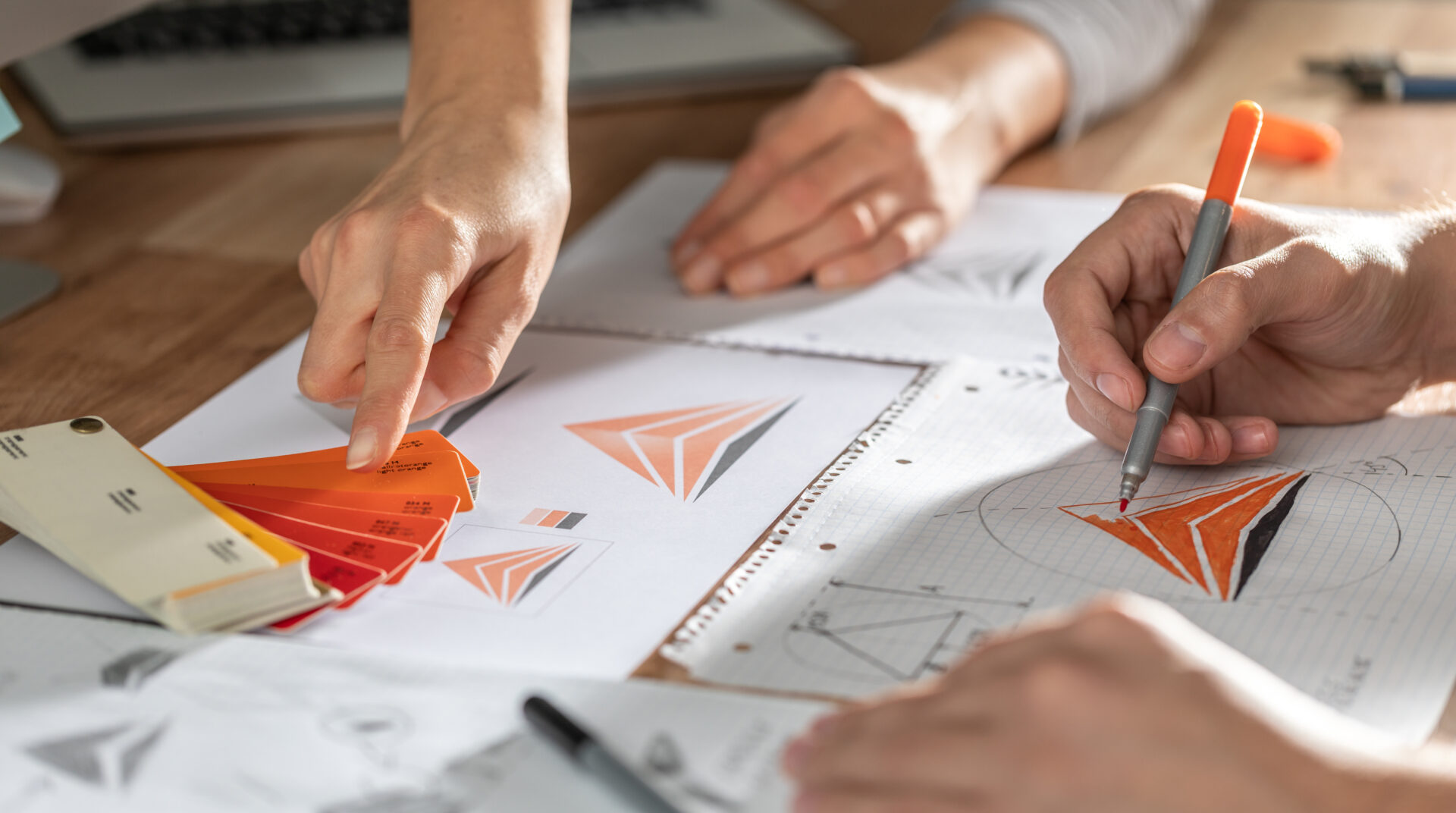
The most straightforward answer to this question may seem, admittedly, a little self-serving, but it’s a tried and tested way to get a good start on the process: hire us. We have decades of experience developing new logos for new and existing companies. Of course, even if you do that, we’re going to ask you a lot of the same questions, so… you may as well keep reading.
Your company’s logo is arguably one of the most essential elements of your business. It’s on everything, from billboards to letterheads; your logo represents your company in its entirety. It is the centerpiece for all of your design work and the face of your company.
Through correct logo usage, you can increase brand retention so that your customers can recognize your business at a split-second glance. But to make something recognizable at a glance, you must spend some serious time deciding what that will look like.
To get started, you need to ask yourself these questions:
Who Is Your Target Market?
All companies have a target audience who are drawn to their products or services, and they fall within a certain age demographic. To advertise successfully to the target age group, you must consider your logo’s graphical approach and color palette. For example, “Toys R Us” has bubbly, colorful letters that attract kids to the store. Or, consider the Prudential Financial logo – a stylized large rocky promontory with simple serif lettering, conveying strength, stability, and permanence.
What Would You Like to Communicate Through Your Logo?
A logo’s purpose goes beyond appearance. Your logo will give your viewers a feel for your company. For instance, is your company youthful, fun, and energetic? Or, is your company serious, scholarly, and deep? In both cases, your logo should portray the essence of your company. What your logo communicates to the viewer will help them associate the attributes of your company with your products and services.
What Characteristics Should Your Logo Have?
Another way to communicate to your viewer what your company represents is to characterize your logo. For example, a law firm’s logo should look more serious than playful and secure rather than adventurous. The characteristics of your logo will help cement what you are communicating to your customers.
What Style Logo Are You Most Drawn Toward?
Choosing the style is one of the most exciting parts of creating a logo. The different style choices provide countless options from which you can choose. Each type uses a different approach to represent the associated company. Consider the following styles:
Pictorial:
The most literal of the logo styles, a picture logo uses a realistic or stylized picture of something to represent a business. This picture can either visualize the company’s main product or the company’s name, even if the image chosen doesn’t relate to the actual products.
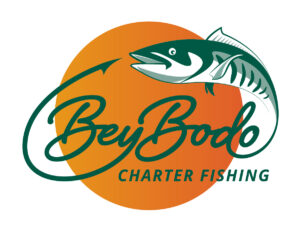
M&R’s designers used an image of a Wahoo, a common game fish that is popular in the Southeastern US, to represent Bey Bodo, a charter fishing service out of Fernandina Beach, FL.
Abstract:
An abstract logo is centered on a design that doesn’t already represent something. Abstract logos are a double-edged sword: creating an entirely new symbol makes you very unlikely to be confused for another company with a similar logo. On the other hand, it does take audiences slightly longer to start recognizing and associating an abstract logo with a particular brand.
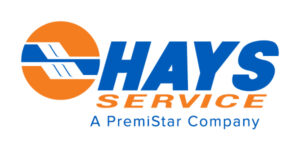
Commercial/Industrial HVAC firm Hays Service partnered with M&R for their new logo. The design calls to mind symbology from engineering diagrams without representing anything specific.
Letters:
Uses one to two letters as the company’s identifying mark. This is one of the most common ways to represent a company named after a person, and, in some cases, the logo presentation ends up becoming the primary way the brand is referred to in public. (Calvin Klein = CK)

The stylized letters “M” and “P” make up the graphical component of this logo M&R designed for Macon Psychiatry, a local behavioral health practice.
Wordmark:
When you choose a wordmark for a logo, your logo is your company’s name, presented in some unique and identifiable way. Selecting a particular unique typeface, having custom lettering designed, or integrating special or meaningful symbols into the words are some ways of changing a company’s name into a logo.

This logo for Land Engineering, a surveying and civil engineering firm based just outside of Atlanta, uses a tech-inspired font to reflect the firm’s forward-looking adoption of new technologies. It also incorporates a stylized cross to showcase the company’s strong sense of faith.
Emblem:
An emblem pairs your company’s name with a particular symbol or pictorial element. An emblem-style logo differs from a pictorial logo in that it integrates the company’s name directly into the logo, and the pictorial element isn’t as likely to be used by itself.

For the Dublin Laurens County Recreation Authority (DLCRA) in Dublin, Georgia, M&R created this logo for their youth sports program. The Legacy Sports logo integrates the initials “LS” into a stylized star.
Characterization:
A character logo uses a mascot or a character to represent the company. This character can be an anthropomorphic version of the company’s product (Planters’ Peanuts, Michelin) or a character created as a marketing device (Buc-ee’s). The character can even be a real-life person, past or present (Col. Sanders, Chef Boyardee – even Smokey the Bear was based on a real-life cub rescued from a forest fire).

The Academy for Classical Education (ACE) is a charter school in Macon, Georgia. They approached M&R to design a logo representing their mascot, the Gryphons.
Got Logo Woes? Call the Pros! Our Talented Designers Have the Tools and the Talent to Bring Your Company to Life With a New Logo. Call Today: 478-621-4491
Taste the Rainbow: Brand Colors
Would UPS still be the business it is today if it weren’t for the brown color (“Pullman Brown”) that the company has been applying to its vehicles since 1919?*
Would Coke be Coke without its signature cherry-red can?
Is it really a Tiffany product if it didn’t come in a robin’s-egg-blue box?
It’s easy to think of color as a strictly aesthetic decision, but it’s so much more than that. Some companies’ signature colors have become even more recognizable than their logo (Tiffany blue). Some lean on it in their advertising – again, we’ll look to UPS and their long-running “What can brown do for you?” campaign.
Your color choices are just as much a part of your branding efforts as the design of your logo or your mission statement. As with any visual element, the colors you choose carry a connotative load that will help define your brand’s voice to your audience. There’s a reason you don’t see many traditional financial institutions with neon purple as a signature color or many toy stores with navy blue and charcoal grey logos.
What colors spring to mind as you look at the characteristics that define your brand and brand voice? What colors do you associate with the values you hold valuable for your brand?
Are you a fun, quirky company? Bright colors will help convey that sense of whimsy to your audience. Want to seem solid and dependable? Dark shades and rich metallic colors are more likely to convey those properties.
Here are some adjectives that are commonly associated with various families of colors:
Red: Excitement, energy, impulsiveness. Red is highly visible and is associated in the West with warning and danger, but also with heroism.

Pink: While hot pink can be young and bold, lighter and less-saturated pinks convey sentiment and romanticism.

Orange: Youthful, creative, adventurous, and unorthodox. Brighter oranges can evoke fire, heat, or an outdoorsy vibe.

Yellow: Optimistic, excited, playful, and happy. When used as an accent against a darker color, it can add an element of youthful playfulness to a brand’s identity.

Green: Natural, clean, sustainable, and healthful. Brighter greens identify companies or initiatives focused on the environment; darker greens can convey wealth and affluence.

Blue: Calm, peaceful, and clean. Lighter blues can carry some of the same connotations as brighter greens; darker blues show a sense of evenness, solidity, and permanence.

Brown: Earthy, honest, organic, wholesome. Browns are commonly found with nature-focused organizations, natural products, sporting goods, and outdoors.

Purple: Royalty, majesty, spirituality, affluence. Rich royal and deep purples can evoke a sense of mystery or can indicate rich, luxurious goods that are slightly decadent.

Black: Sophistication, elegance, stylishness, modernity. Black is considered the ne plus ultra of wealth and grandeur (consider the American Express Black card).

White: Cleanliness, simplicity, innocence, creativity. White is commonly used in minimalist design and can create a feeling of potential by presenting a “blank slate” to the audience.

*Interesting history note: UPS’s early service relied on first-class service on railroads to make fast deliveries – the company borrowed the signature brown of the Pullman Company’s famous passenger cars to lend its business an air of quality and reliability. UPS’s use of “Pullman Brown” has so far outlasted Pullman’s last company-operated rail car by more than 75 years.
Additional “color commentary:” The Pullman Company started painting their cars brown because the dark color didn’t show soot stains as readily while being pulled by the era’s coal-burning locomotives. Takeaway: Even strictly functional color decisions can long outlive their original purpose and become central to an entire brand!
They’re Just Fonts, Right?
Wrong.
It’s easy to overlook the importance of font selection as part of your branding effort. After all, the important thing is what the words say, not how the letters are shaped, right?
Well, not exactly. The font or typeface used for your branded materials can carry considerable emotional connotations. Take a look at the following sentence:
Since 2005, our team has been delivering quality service at an unbeatable price.
That’s a reasonably generic marketing statement that, with a few changes, could be used by just about any business owner. Now, take a look at it in a few different fonts:
Since 2005, our team has been delivering quality service at an unbeatable price.
(Georgia)
Since 2005, our team has been delivering quality service at an unbeatable price.
(Open Sans)
Since 2005, our team has been delivering quality service at an unbeatable price.
(Rockwell)
They all say the same thing, but they say it in vastly different ways.
“Georgia” conveys a traditional vibe that’s solid and dependable without being stuffy. It’s approachable – the company that chose this font wants you to know they’re reliable and friendly.
“Open Sans” is almost stereotypically contemporary. It’s clean, displays well on screens, and messages comfort with digital technology. This is a company that embraces technological solutions and values accessibility.
“Rockwell” is surprisingly robust. It calls to mind old-West style letterpress fonts, carrying a certain “rugged independence” vibe that works great for DIY products. This company celebrates creativity and has a hands-on ethic.
The emotional implications of a font can cut both ways. Choosing the right font can reinforce your brand’s voice, steering your audience toward a conversion by putting them into the right mindset to receive your message positively. Choosing the wrong font can lead the audience in the wrong direction emotionally, create a sense of dissonance, and turn audience members away from your message:

How comfortable would you be trusting your money to an investment firm that used this font for their website?
On Thursday, it’s time to rock out with metal legends Deathmole and Spinal Tap.
How much fun do you think this show will be for a true metalhead?
How Do I Choose a Font?
Building a font library for your brand starts with the answer to a fundamental question: what’s the mood you want your brand to convey? When you’re thinking about this, consider terms like:
- Solid
- Reliable
- Fun
- Cheeky
- Sporty
- Youthful
- Approachable
- Caring
Try to boil it down to only two or three words that communicate the essence of your brand’s voice.
Now, look at other brands that you identify with those particular adjectives. What types of fonts do they use?
Serif Fonts
Serif fonts have small “feet” at the tops and bottoms of the characters. Most designers consider serif fonts easier to read on paper, and nearly every book published in the modern world is set in a serif typeface.
Serif fonts are very traditional and can convey a sense of age, dependability, wisdom, or classicism. Care must be taken with these fonts to avoid being stuffy, unchanging, or inaccessible.
Sans-Serif Fonts
Sans-serif fonts lack “feet” and tend to use letter shapes that more closely resemble the way humans write block letters. Sans-serif fonts originated in the 18th century but came into their own during the last half of the 20th century when fonts like Helvetica ushered in a new era of clean, humanist design.
Sans-serif fonts are more casual and are more easily read on a screen than serif fonts. They carry connotations like approachable, techy, and accessible without being frivolous or flighty.
Display Fonts
All of the “fun” fonts that came installed on your computer, many logos using custom lettering, and some of the best (and worst) fonts in the world are display fonts. They don’t fit neatly into the serif or sans serif category and are typically used only for headlines, banners, and other places where they’ll be used for only one or two lines of text.
Display fonts can be an excellent choice for splashy headings but shouldn’t be considered for body copy – they’re hard to read in large chunks and read as unprofessional when used in that way. Their emotional loads cover the spectrum, from athletic to antiestablishment, medieval to hypermodern.
Font Pairings
It’s common to see a single font in different formats filling every role in a design – headlines, subheadings, body text, callouts, and more. That’s an excellent option for most brands and can create a look of complete consistency.
Using a variety of fonts, however, can create a more engaging design and improve legibility by making a more precise delineation between headings and body copy. When selecting fonts to put together as a library for your brand, you must ensure that the fonts you choose work well together. There are dozens of websites that can help you find fonts that will complement one another, or you can do it the old-fashioned way and start putting fonts together to see what looks best.
Be careful – designs with too many fonts look busy, amateurish, and hard to read. The old rule for designers was to make sure any design had no more than three fonts, which is still a pretty good rule to follow today. Your brand standard should include no more than three fonts: one for headlines (which may be the same font that’s used in your company’s logo), one for subheadings and special text, and then a third for body copy.
A Few Examples of Various Fonts and How Audiences view them:
Garamond
A longtime favorite for designers wishing to impart a classic, academic, highly legible feel to long blocks of text.
Helvetica
The definitive sans-serif font, Helvetica is one of the most commonly used typefaces in the world. Helvetica offers a clean, no-nonsense look that works as well today as it did when it was introduced in 1957.
Century Gothic
Century Gothic is a geometric font that is light and modern and works well to convey contemporary elegance. It works far better as a headline or callout font than a body copy font.
Gotham
Gotham is an incredibly versatile sans-serif that’s available in a wide variety of weights. It is often used in single-font applications since it works equally well as a display font, heading, and body copy.
Trajan
Another example of a good display font that isn’t quite right for large blocks of text, Trajan has a neo-classical look that communicates solidity and tradition. Thanks to its resemblance to the neo-classical lettering on courthouses and government offices (and its use as the title font for the TV show “The West Wing”), it’s also become associated with government and political campaigns.
Once More, From the Top: Rebranding
Now that your brand is established, it’s time to start over again!
No, not really. But it is important to remember – so crucial that we’re going to repeat it – that you must evaluate your branding efforts on an ongoing basis. Unlike some of the specific practices and definite metrics we’ve relied on in talking about assessment in our other Definitive Guides, assessing your branding efforts requires a truly overall look at your business and its performance.
Is your business successful? Are you meeting goals, getting good reviews, and seeing high customer (and employee) satisfaction? Those are all indicators that your branding efforts have been more or less successful.
If you want more specifics, you can dig into some metrics and do some focused market research to find out how well certain aspects of your brand are performing:
- Looking at your website’s branded search traffic can speak to overall brand recognition – if people are searching for your company’s name, they’ve clearly heard it or seen it somewhere. Higher branded search volumes indicate higher brand recognition.
- Performing split tests in an email marketing campaign or with a digital ad campaign, with one piece relying heavily on your logo and the other relying more heavily on your name, can show how well people associate your logo with your company.
- Marketing surveys of a broad audience or focus groups with a targeted, selected audience can give you even better insight into how people perceive your brand. Even your online reviews can provide helpful information about your brand perception.
If your brand is underperforming and not representing your company well, then it may be time to reevaluate one or more of the elements of your branding.
Branding is a lot like fashion—one day, your brand engages your audience and serves your message well, but the next day, it’s stale and outdated. When selecting a logo, don’t be tempted to base your decision on what’s trendy today. Choosing a more timeless design will ensure that your logo has a better shelf life and will prevent you from needing to perform a costly rebrand sooner than you otherwise would.
Rebranding is necessary to keep up with current marketing trends and thrive in commerce. To help you determine if you need a rebrand right now, take a look at these three indicators:
1. Your Business Has Shifted, Expanded, or Refocused
If you have been in business for a decade or longer, your current business model probably looks different from when you first started. Your business changes over the years as you introduce new services and products to serve your customers best and grow your company. Your efforts or focal points have likely evolved, but your branding may not have been updated to reflect those shifts, expansions, or changes in direction.
If your brand still accurately represents the company you were when you first started, then now might not be the time to rethink things. But, if your current branding speaks to the company you once were and not the company you are now, it’s time to consider rebranding and achieving coherence between who you are and how you represent yourself.
Take Apple, for instance. When it first launched in 1976, its logo was busy with a scenic image of Isaac Newton sitting at the base of a tree and an apple dangling overhead. The wordmark was also busy with “Apple Computer Co.” in all caps featured on a ribbon wrapped around the logomark.
It’s a lot for a logo and looks outdated, even for the ’70s. The logo didn’t last long – Apple rebranded a year later with the first version of the bitten apple we recognize now. Steve Jobs wanted something more simplified and sleeker to reflect modern computer design trends.
In the late ’90s, the company rebranded again, focusing its marketing on the individual user and adopting the clean, content-light marketing approach that made it famous during the iMac era – along with a cleaner, single-color Apple logo.
It only took Apple a year to rebrand the first time and a couple of years to rebrand the second time completely – but had it stuck with the Newton logo, its outdated logo would have conflicted with its modernized products and could have hindered sales, proving how important it is to update your branding elements to match your current business efforts.
2. Your Audience Has Changed
Whether your company is branded to reach a particular demographic or anyone and everyone, your branding should keep your target audience in mind. Typically, brands that include modern or trendy elements speak to the younger consumers in your target audience. But as time passes, preferences change, styles become outdated, different trends take over, audiences age, and new generations arrive.
When the time comes, it’s crucial to market to the next generation of consumers to stay in business and grow as a company. Often, a rebranding is necessary to appeal to a newer, younger audience without losing the attention of your existing audience.
Take the current minimalistic design trend, for instance. The past decade or so has seen ultra-simplified logo designs that are clean, monotoned, and minimalistic to reflect the simplified processes created by the Information Age. Thanks to technological advancements and innovations, pretty much everything has become user-friendly and user-focused—in other words, simplified—and is what younger consumers have always known, generally speaking.
Before, designs were busier, often three-dimensional and saturated with brighter colors. Now, brands have clean, modern, and minimal logos that convey simplicity and sophistication. Mission statements that were longer and more florid and brand values that were more traditional and focused on profitability have become shorter, more digestible, and more focused on projecting the company as a force for good in the community or market.
Overall, the trend for brands in the past several years has been towards increased approachability, informality, and stewardship. Eventually, these brands must be redesigned to speak to whatever trends the next generation of consumers will inspire, and the cycle will continue.
3. Your Current Brand Is Decades Old or Has Outdated Elements
Directly related to reason #2, consider a rebrand if your current branding has been around for decades or has outdated elements. An old or outdated logo can tell audiences several things:
- You don’t care about your brand enough to keep it up-to-date and modern.
- You don’t care about your audience enough to update and improve your brand messaging.
- You are an old, outdated company, or at least that is how you wantto be seen.
Old or outdated brands can create a sense of stagnancy or staleness among your audiences, even if your products and services are neither.
So, what is an outdated element? Anything that is not a staple of your brand, evergreen, or on trend with today’s commercial culture can be viewed as outdated. Examples can include:
- Missions, visions, and values that:
- Focus on profitability or growth at the cost of positive stewardship
- Ignore the company’s role in the community
- Speak to “future” growth that’s already occurred
- Are overly “corporate” or “buzz-y” or are excessively long or broad
- Logos, designs, and visual elements featuring:
- Serif fonts
- Cursive fonts
- Three-dimensional designs
- Frames around the entire logo
- Busy logomarks
- Loud, saturated colors
This list is not exhaustive, nor does it mean you should avoid outdated elements at all costs. One way to recapture your audience’s attention is to use something normally considered old in a fresh, new way. When executed well, a logo can keep an older element or two while changing other outdated elements, putting a unique and interesting twist on an old design.
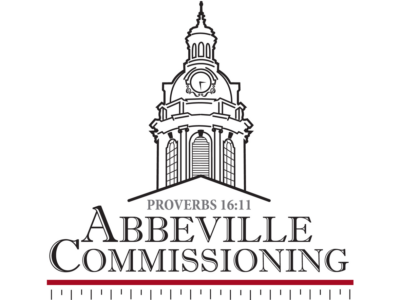
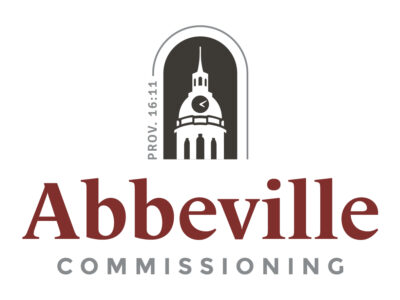
When Abbeville Commissioning, a South Georgia engineering firm, needed to rebrand, they relied on M&R’s talented designers to convert their old logo (left) into a new, more updated version (right).
Do I Have to Do All This Again?
Yes, but fortunately, you already know how to do that – you just finished reading an entire article about it! The process for rebranding is more or less identical to building a new brand from scratch, with the added benefit of already knowing many of the answers to the questions you’ll be asking yourself and your team along the way.
The main thing to look out for in rebranding is inertia. A body in motion will tend to remain in motion along the same trajectory unless acted upon by an outside force, and brands have an inertia all their own. During a rebranding, it’s easy to:
- Fall victim to the inertia of your existing brand and fail to consider changing elements that might need to be changed, due to a sense of tradition or a mistaken belief that your old brand is more effective than it actually is or
- Fall victim to the inertia of the new brand and emerge with the process with something so incredibly different from your old branding that it leads to market confusion as people try to figure out who and what you are.
As you rebrand, look at every single element of your existing brand. Evaluate it both objectively and subjectively. Get members from every part of your company involved. Do market research, then do some more market research. Test new ideas through A/B or split testing. In other words, give yourself more than enough information to base every single decision on and avoid guesswork to the greatest extent possible.
Once you’ve decided on your new branding, you also need to decide on how to roll out your new corporate identity. Sometimes, a complete rebrand is launched suddenly, with little to no warning, and all at once. Sometimes, it’s gradually implemented over months or even years. The scope of the rebrand will inform a lot of that decision – updating a mission statement or changing a logo that only appears in a few places will be considerably faster than launching a new logo for a major airline or chain of retailers when just changing signage alone could take years (there are still Target locations using the all-caps wordmark that was nominally “replaced” by today’s all-lowercase version in 2018).
Branding Wrap-Up
Whew! This article has covered a lot, and we hope you’ve gotten a lot out of it. Branding is crucial, and while we call these articles “Definitive Guides,” trying to define every single aspect of branding would require several dozen articles this long or longer. The main things to remember, though, can be summed up in three points:
- Your brand must reflect your company as it is and must convey the attitudes and emotions you want to your audience.
- Your brand must be applied consistently and kept as undiluted by off-brand messaging and design as possible.
- Your brand must constantly be evaluated for performance and reconsidered whenever your business, market, or trends dictate.
If you are careful and intentional in crafting a brand that speaks to your company and its goals, use it consistently, and remain open to changing it as needed, you will see the benefits of having a unified corporate identity: better customers, more volume, and a guiding framework for making the tough decisions that come with running a business.
Need Some Help Branding, Rebranding, or Even Re-Rebranding Your Business?
We have the expertise and the skills needed to help you define, build, and leverage your brand to help you find success in any market segment. Talk to one of our friendly account managers today and discover how M&R Marketing can get you on the right path to an effective, recognizable brand. 478-621-4491

